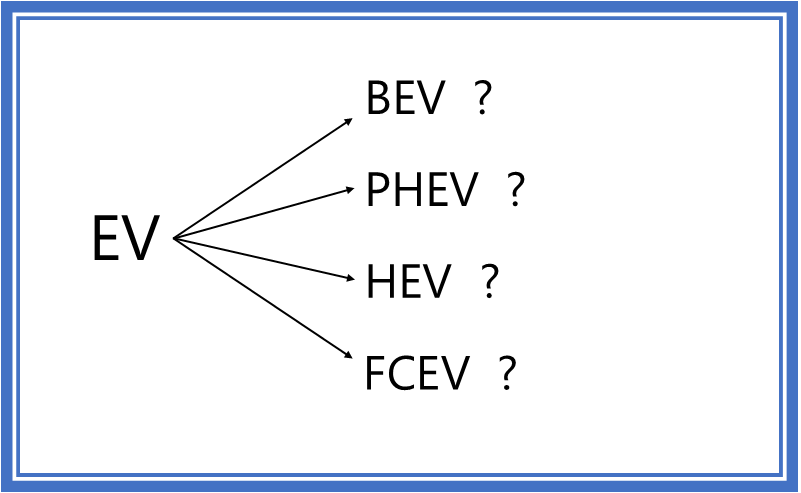Electric Vehicle Review: BEV, PHEV, HEV, or FCEV?
DOI:
https://doi.org/10.21009/JKEM.10.1.8Keywords:
electric vehicle; renewable energy; batteries; hydrogen; fuel-cellAbstract
Electric vehicles (EVs) are rapidly advancing as a sustainable transportation solution in the global effort to reduce carbon emissions. There are four main types of EVs: battery electric vehicles (BEVs), plug-in hybrid electric vehicles (PHEVs), hybrid electric vehicles (HEVs), and fuel cell electric vehicles (FCEVs). This article reviews each EV type's advantages, limitations, and prospects based on energy efficiency, carbon emissions, technological development, and infrastructure readiness. The findings indicate that BEVs hold the most significant potential for personal vehicles and urban transportation, while FCEVs are more suited for heavy-duty and long-distance applications. PHEVs and HEVs are considered transition solutions, but their relevance is expected to decrease as technology and global policies evolve. BEVs provide zero emissions. PHEVs provide high flexibility, while HEVs do not require charging infrastructure, and FCEVs offer zero emissions and long-range and fast charging times. FCEV can travel up to more than 800 KM, which is very promising for the distance travelled problem, which is a challenge for electric vehicles.
References
[1] S. Awaworyi Churchill, J. Inekwe, K. Ivanovski, and R. Smyth, “Transport infrastructure and CO2 emissions in the OECD over the long run,” Transp. Res. Part D Transp. Environ., vol. 95, p. 102857, 2021, doi: 10.1016/j.trd.2021.102857.
[2] Y. Wang, J. Liu, D. Guan, J. Meng, Z. Liu, S. Xiang, H. Yang, X. Fu, X. Hu, Q. Yang, K. Yi, Y. Zhang, J. Ma, X. Wang, and S. Tao, “The volume of trade-induced cross-border freight transportation has doubled and led to 1.14 gigatons CO2 emissions in 2015,” One Earth, vol. 5, no. 10, pp. 1165–1177, 2022, doi: 10.1016/j.oneear.2022.09.007.
[3] D. D. Kania, D. A. Arubusman, and M. Sari, “Sektor penerbangan global dalam isu perubahan iklim : dampak dan mitigasinya,” J. Manaj. Transp. Logistik, vol. 8, no. 2, p. 133, 2022, doi: 10.54324/j.mtl.v8i2.713.
[4] R. D. Purnomoasri and D. Handayani, “Analisis dan mitigasi emisi gas buang akibat transportasi (studi kasus kabupaten magetan),” ENVIRO J. Trop. Environ. Res., vol. 24, no. 1, p. 29, 2022, doi: 10.20961/enviro.v24i1.65043.
[5] Y. Serlina, F. A. Putra, R. A. Lestari, and V. S. Bachtiar, “Analisis jejak karbon dari aktivitas transportasi di universitas andalas,” J. Serambi Eng., vol. IX, no. 3, pp. 9889–9897, 2024.
[6] P. Hendratmoko and Y. E. R. U. Dewantoro, “Pemetaan emisi co2 hasil kontribusi kegiatan transportasi di kota tegal jawa tengah,” J. Keselam. Transp. Jalan (Indonesian J. Road Safety), vol. 5, no. 2, pp. 19–28, 2018, doi: 10.46447/ktj.v5i2.46.
[7] M. Hirz, H. Brunner, and T. T. Nguyen, “Greenhouse gas emissions of electric cars - a comprehensive evaluation,” Teh. Glas., vol. 16, no. 2, pp. 280–287, 2022, doi: 10.31803/tg-20220407135956.
[8] F. Alanazi, “Electric Vehicles: benefits challenges and potential solutions for widespread adaptation,” J. Appl. Sci., vol. 13, pp. 1–23, 2023, doi: 10.3390/app13106016.
[9] G. Zola, S. D. Nugraheni, A. A. Rosiana, D. A., Pambudy, and N. Agustanta, “Inovasi kendaraan listrik sebagai upaya meningkatkan kelestarian lingkungan dan mendorong pertumbuhan ekonomi hijau di Indonesia,” Ekon. Sumberd. dan Lingkung., vol. 11, no. 3, pp. 2303–1220, 2023, doi: 10.22437/jesl.v12i3.30229.
[10] C. Sudjoko, “Strategi pemanfaatan kendaraan listrik berkelanjutan sebagai solusi untuk mengurangi emisi karbon”, Jurnal Paradigma: Jurnal Multidisipliner Mahasiswa Pascasarjana Indonesia,” J. Paradig. J. Multidisipliner Mhs. Pascasarj. Indones., vol. 2, no. 2, pp. 54–68, 2021, doi: 10.22146/jpmmpi.v2i2.70354.
[11] D. De Wolf and Y. Smeers, “Comparison of battery electric vehicles and fuel cell vehicles,” World Electr. Veh. J., vol. 14, no. 9, pp. 1–13, 2023, doi: 10.3390/wevj14090262.
[12] S. Vengatesan, A. Jayakumar, and K. K. Sadasivuni, “FCEV vs. BEV — A short overview on identifying the key contributors to affordable & clean energy (SDG-7),” Energy Strateg. Rev., vol. 53, no. March, p. 101380, 2024, doi: 10.1016/j.esr.2024.101380.
[13] I. C. Setiawan, “Policy simulation of electricity-based vehicle utilization in indonesia (Electrified vehicle-HEV, PHEV, BEV and FCEV),” Automot. Exp., vol. 2, no. 1, pp. 1–8, 2019, doi: 10.31603/ae.v2i1.2020.
[14] Y. Ligen, H. Vrubel, and H. H. Girault, “Mobility from renewable electricity: Infrastructure comparison for battery and hydrogen fuel cell vehicles,” World Electr. Veh. J., vol. 9, no. 1, 2018, doi: 10.3390/wevj9010003.
[15] H. Limanseto, “Menko airlangga : perkembangan EV perlu terus didorong untuk mewujudkan masa depan transportasi yang ramah lingkungan, inklusif, dan modern,” Kementeri. Koord. Bid. Perekon. REPUBLIK Indones., 2024.
[16] I. P. G. Suartika, “Percepatan pengembangan industri kendaraan listrik guna mendorong transformasi ekonomi hijau (green economy) yang berkelanjutan,” Lemb. Ketahanan Nas. Republik Indones., pp. 1–76, 2023.
[17] A. Wahyudi, “Strategi kebijakan peningkatan sektor transportasi publik di jakarta menuju net zero emission,” J. Ris. Ekon., vol. 4, no. 2, pp. 557–570, 2024.
[18] Meilani, “Kebijakan insentif kendaraan listrik,” Pus. Anal. Keparlemenan Bid. Ekon. Keuangan, Ind. dan Pembang., vol. 15, 2023.
[19] A. Nasution and H. T. Azmi, “Tinjauan yuridis pemberian insentif dalam rangka mendorong percepatan battery electric vehicle (BEV): Potensi Dukungan pada Greenwashing Dibalik Solusi Persoalan Lingkungan,” Pres. J. Hukum, Adm. Negara, dan Kebijak. Publik, vol. 1, no. 3, pp. 57–70, 2024, doi: 10.62383/presidensial.v1i3.76.
[20] T. Gül, A. F. Pales, and E. Connelly, “Global EV outlook 2024 moving towards increased affordability,” Electr. Veh. Intitiative , p. 79, 2024, [Online]. Available: www.iea.org
[21] I. Veza, M. Z. Asy’ari, M. Idris, V. Epin, I. M. R. Fattah, and M. Spraggon, “Electric vehicle (EV) and driving towards sustainability: comparison between EV, HEV, PHEV, and ICE vehicles to achieve net zero emissions by 2050 from EV,” Alexandria Eng. J., vol. 82, pp. 459–467, 2023, doi: 10.1016/j.aej.2023.10.020.
[22] S. Micari and G. Napoli, “Electric Vehicles for a flexible energy system: challenges and opportunities,” Energies, vol. 17, no. 22, 2024, doi: 10.3390/en17225614.
[23] H. Fathabadi, “Plug-in hybrid electric vehicles: replacing internal combustion engine with clean and renewable energy based auxiliary power sources,” IEEE Trans. Power Electron., vol. 33, no. 11, pp. 9611–9618, 2018, doi: 10.1109/TPEL.2018.2797250.
[24] S. Jain and L. Kumar, "Fundamentals of Power Electronics Controlled Electric Propulsion, 4th ed.," Elsevier Inc., 2017. doi: 10.1016/B978-0-12-811407-0.00035-0.
[25] S. A. Qadir, F. Ahmad, A. Mohsin A. B. Al-Wahedi, A. Iqbal, and A. Ali, “Navigating the complex realities of electric vehicle adoption: A comprehensive study of government strategies, policies, and incentives,” Energy Strateg. Rev., vol. 53, p. 101379, 2024, doi: 10.1016/j.esr.2024.101379.
[26] A. Pamidimukkala, S. Kermanshachi, J. M. Rosenberger, and G. Hladik, “Barriers and motivators to the adoption of electric vehicles: A global review,” Green Energy Intell. Transp., vol. 3, no. 2, p. 100153, 2024, doi: 10.1016/j.geits.2024.100153.
[27] A. S. Al-Adsani and O. Beik, “Electric and hybrid electric powertrains,” Multiph. Hybrid Electr. Mach., no. March, pp. 143–170, 2022, doi: 10.1007/978-3-030-80435-0_5.
[28] K. V. Singh, H. O. Bansal, and D. Singh, “A comprehensive review on hybrid electric vehicles: architectures and components,” J. Mod. Transp., vol. 27, no. 2, pp. 77–107, 2019, doi: 10.1007/s40534-019-0184-3.
[29] J. A. Gómez and D. M. F. Santos, “The status of on-board hydrogen storage in fuel cell electric vehicles,” Designs, vol. 7, no. 4, 2023, doi: 10.3390/designs7040097.
[30] “Road map to A US Reducing emissions and driving growth across the nation”, [Online]. Available: https://h2fcp.org/sites/default/files/Road+Map+to+a+US+Hydrogen+Economy+Full+Report.pdf
[31] A. Soleimani, S. H. H. Dolatabadi, M. Heidari, A. Pinnarelli, B. M. Khorrami, Y. Luo, P. Vizza, G. Brusco, “Progress in hydrogen fuel cell vehicles and up-and-coming technologies for eco-friendly transportation: an international assessment,” Multiscale Multidiscip. Model. Exp. Des., vol. 7, no. 4, pp. 3153–3172, 2024, doi: 10.1007/s41939-024-00482-8.
[32] A. Albatayneh, A. Juaidi, M. Jaradat, and F. Manzano-Agugliaro, “Future of electric and hydrogen cars and trucks: an overview,” Energies, vol. 16, no. 7, 2023, doi: 10.3390/en16073230.
[33] T. Selmi, A. Khadhraoui, and A. Cherif, “Fuel cell–based electric vehicles technologies and challenges,” Environ. Sci. Pollut. Res., vol. 29, no. 52, pp. 78121–78131, 2022, doi: 10.1007/s11356-022-23171-w.
[34] O. Fakhreddine, Y. Gharbia, J. F. Derakhshandeh, and A. M. Amer, “Challenges and solutions of hydrogen fuel cells in transportation systems: a review and prospects,” World Electr. Veh. J., vol. 14, no. 6, 2023, doi: 10.3390/wevj14060156.
[35] E. Yuliandari and L. N. Violie, “Electric vehicle policy based on juridical foundation to realize environmental resilience in indonesia,” Proc. Int. Conf. Democr. Natl. Resil. (ICDNR 2021), vol. 620, pp. 37–44, 2022, doi: 10.2991/assehr.k.211221.007.
[36] A. Faraz, A. Ambikapathy, S. Thangavel, K. Logavani, and G. A. Prasad, “Battery electric vehicles (BEVs),” Green Energy Technol., pp. 137–160, 2021, doi: 10.1007/978-981-15-9251-5_8.
[37] C. Sudjoko, N. A. Sasongko, I. Utami, and A. Maghfuri, “Utilization of electric vehicles as an energy alternative to reduce carbon emissions,” IOP Conf. Ser. Earth Environ. Sci., vol. 926, 2021, doi: 10.1088/1755-1315/926/1/012094.
[38] R. Kene, T. Olwal, and B. J. van Wyk, “Sustainable electric vehicle transportation,” Sustain., vol. 13, no. 22, 2021, doi: 10.3390/su132212379.
[39] A. Jannesar Niri, G. A. Poelzer, S. E. Zhang, J. Rosenkranz, M. Pettersson, and Y. Ghorbani, “Sustainability challenges throughout the electric vehicle battery value chain,” Renew. Sustain. Energy Rev., vol. 191, 2023, p. 114176, 2024, doi: 10.1016/j.rser.2023.114176.
[40] V. J. Reddy, N. P. Hariram, R. Maity, M. F. Ghazali, and S. Kumarasamy, “Sustainable vehicles for decarbonizing the transport sector: a comparison of biofuel, electric, fuel cell and solar-powered vehicles,” World Electr. Veh. J., vol. 15, no. 3, 2024, doi: 10.3390/wevj15030093.
[41] X. Zhao, H. Hu, H. Yuan, and X. Chu, “How does adoption of electric vehicles reduce carbon emissions? Evidence from china,” Heliyon, vol. 9, no. 9, p. e20296, 2023, doi: 10.1016/j.heliyon.2023.e20296.
[42] R. Kumar A. Kanwal, M. Asim, M. Pervez, M. A. Mujtaba, Y. Fouad, and M. A. Kalam, “Transforming the transportation sector: mitigating greenhouse gas emissions through electric vehicles (EVs) and exploring sustainable pathways,” AIP Adv., vol. 14, no. 3, pp. 1–15, 2024, doi: 10.1063/5.0193506.
[43] M. Aziz, Y. Marcellino, I. A. Rizki, S. A. Ikhwanuddin, and J. W. Simatupang, “Studi analisis perkembangan teknologi dan dukungan pemerintah indonesia terkait mobil listrik,” TESLA J. Tek. Elektro, vol. 22, no. 1, p. 45, 2020, doi: 10.24912/tesla.v22i1.7898.
[44] G. S. Lakshmi, R. Olena, G. Divya, and R. Oleksandr, “Battery energy storage technologies for sustainable electric vehicles and grid applications,” J. Phys. Conf. Ser., vol. 1495, 2020, doi: 10.1088/1742-6596/1495/1/012014.
[45] G. G. Njema, R. B. O. Ouma, and J. K. Kibet, “A review on the recent advances in battery development and energy storage technologies,” J. Renew. Energy, vol. 2024, pp. 1–35, 2024, doi: 10.1155/2024/2329261.
[46] S. S. Rangarajan, S. P. Sunddararaj, AVV Sudhakar, C. K. Shiva, U. Subramaniam, E. R. Collins and T. Senjyu, “Lithium-Ion batteries—the crux of electric vehicles with opportunities and challenges,” Clean Technol., vol. 4, no. 4, pp. 908–930, 2022, doi: 10.3390/cleantechnol4040056.
[47] A. A. Nkembi, M. Simonazzi, D. Santoro, P. Cova, and N. Delmonte, “Comprehensive Review of Energy Storage Systems Characteristics and Models for Automotive Applications,” Batteries, vol. 10, no. 3, 2024, doi: 10.3390/batteries10030088.
[48] D. A. Elalfy, E. Gouda, M. F. Kotb, V. Bureš, and B. E. Sedhom, “Comprehensive review of energy storage systems technologies, objectives, challenges, and future trends,” Energy Strateg. Rev., vol. 54, 2024, doi: 10.1016/j.esr.2024.101482.
[49] A. Nugraha et al., “Pertamina Energy Outlook,” Pertamina, pp. 1–172, 2022.
[50] A. Pamidimukkala, S. Kermanshachi, J. M. Rosenberger, and G. Hladik, “Evaluation of barriers to electric vehicle adoption: a study of technological, environmental, financial, and infrastructure factors,” Transp. Res. Interdiscip. Perspect., vol. 22, no. November, p. 100962, 2023, doi: 10.1016/j.trip.2023.100962.
[51] O. Egbue and S. Long, “Barriers to widespread adoption of electric vehicles: An analysis of consumer attitudes and perceptions,” Energy Policy, vol. 48, no. 2012, pp. 717–729, 2012, doi: 10.1016/j.enpol.2012.06.009.
[52] I. for T. and D. P. (ITDP), “Keadaan dan tantangan adopsi bus listrik untuk transportasi publik di indonesia elektrifikasi untuk masa depan,” White Pap., p. 100, 2023.
[53] M. S. Mastoi, S. Zhuang, H. M. Munir, M. Haris, M. Hassan, M. Usman, S. S. H. Bukhari, and J.-S. Ro, “An in-depth analysis of electric vehicle charging station infrastructure, policy implications, and future trends,” Energy Reports, vol. 8, pp. 11504–11529, 2022, doi: 10.1016/j.egyr.2022.09.011.
[54] J. Halbey, S. Kowalewski, and M. Ziefle, “Going on a road-trip with my electric car: Acceptance criteria for long-distance-use of electric vehicles,” Lect. Notes Comput. Sci. (including Subser. Lect. Notes Artif. Intell. Lect. Notes Bioinformatics), vol. 9188, pp. 473–484, 2015, doi: 10.1007/978-3-319-20889-3_44.
[55] H. H. J.M., Usmar, and H. Prihanto, “Persepsi masyarakat untuk mengunakan kendaraan listrik roda empat ramah lingkungan,” J. Manaj. Dan Bisnis, vol. 3, no. 2, pp. 165–175, 2023.
[56] E. Permana, S. K. N. Rahayu, S. S. Hanum, and Syamsurizal, “Penerapan strategi pemasaran produk wuling air EV dalam menarik minat pembelian konsumen terhadap mobil listrik,” J. Ekon. Akuntansi, dan Perpajak., vol. 1, no. 3, pp. 243–257, 2024, doi: 10.61132/jeap.v1i3.307.
[57] Z. Kang, Z. Huang, Q. Peng, Z. Shi, H. Xiao, R. Yin, G. Fu, and J. Zhao, “Recycling technologies, policies, prospects, and challenges for spent batteries,” iScience, vol. 26, no. 11, p. 108072, 2023, doi: 10.1016/j.isci.2023.108072.
[58] J. P. Skeete, P. Wells, X. Dong, O. Heidrich, and G. Harper, “Beyond the event horizon: battery waste, recycling, and sustainability in the united kingdom electric vehicle transition,” Energy Res. Soc. Sci., vol. 69, 2019, p. 101581, 2020, doi: 10.1016/j.erss.2020.101581.
[59] M. C. Jena, S. K. Mishra, and H. S. Moharana, “Challenges and way forward in the handling and disposal of battery waste: towards sustainable practices,” Sustain. Soc. Dev., vol. 7, no. 2, p. 7048, 2024, doi: 10.24294/tse.v7i2.7048.
[60] E. Moscardini, L. Baldassari, F. Forte, I. Falcone, J. Coletta, and L. Toro, “A systematic review of battery recycling technologies: advances, challenges, and future prospects,” Energies, vol. 16, no. 18, pp. 1–24, 2023, doi: 10.3390/en16186571.
[61] S. Xiaodong and V. Ishchenko, “Environmental impact analysis of waste lithium-ion battery cathode recycling,” J. Ecol. Eng., vol. 25, no. 7, pp. 352–358, 2024, doi: 10.12911/22998993/189187.
[62] E. E. Agency, "Electric vehicles from life cycle and circular economy perspectives - TERM 2018: Transport and Environment Reporting Mechanims (TERM)," EEA report, no. 13. 2018.
[63] R. León, C. Montaleza, J. L. Maldonado, M. Tostado-Véliz, and F. Jurado, “Hybrid electric vehicles: a review of existing configurations and thermodynamic cycles,” Thermo, vol. 1, no. 2, pp. 134–150, 2021, doi: 10.3390/thermo1020010.
[64] A. G. Olabi, T. Wilberforce, K. Obaideen, E. T. Sayed, N. Shehata, A. H. Alami, and M. A. Abdelkareem, “Micromobility: Progress, benefits, challenges, policy and regulations, energy sources and storage, and its role in achieving sustainable development goals,” Int. J. Thermofluids, vol. 17, p. 100292, 2023, doi: 10.1016/j.ijft.2023.100292.
[65] F. Un-Noor, S. Padmanaban, L. Mihet-Popa, M. N. Mollah, and E. Hossain, “A comprehensive study of key electric vehicle (EV) components, technologies, challenges, impacts, and future direction of development,” Energies, vol. 10, no. 8, 2017, doi: 10.3390/en10081217.
[66] D. Regina and N. M. Ulmi, “Tantangan Pengembangan mobil listrik menuju transportasi berkelanjutan di indonesia,” J. Penelit. Sekol. Tinggi Transp. Darat, vol. 14, no. 1, pp. 32–39, 2023, doi: 10.55511/jpsttd.v14i1.605.
[67] S. Vasiljević, B. Aleksandrović, J. Glišović, and M. Maslać, “Regenerative braking on electric vehicles: working principles and benefits of application,” IOP Conf. Ser. Mater. Sci. Eng., vol. 1271, p. 012025, 2022, doi: 10.1088/1757-899x/1271/1/012025.
[68] C. Armenta-Déu and H. Cortés, “Analysis of Kinetic energy recovery systems in electric vehicles,” Vehicles, vol. 5, no. 2, pp. 387–403, 2023, doi: 10.3390/vehicles5020022.
[69] B. Güney and H. Kiliç, “Research on regenerative braking systems: a review,” Int. J. Sci. Res. , vol. 9, no. 9, pp. 160–166, 2020, doi: 10.21275/SR20902143703.
[70] H. Zhang, D. Chen, H. Zhang, and Y. Liu, “Research on the influence factors of brake regenerative energy of pure electric vehicles based on the CLTC,” Energy Reports, vol. 8, pp. 85–93, 2022, doi: 10.1016/j.egyr.2022.10.259.
[71] J. Marbun, M. Sigiro, B. T. M. Purba, and J. Tamba, “Potensi dan tantangan penggunaan kendaraan listrik di kota medan sebagai bahan ajar untuk pendidikan fisika UHN,” J. Educ. Res., vol. 4, no. 4, pp. 2542–2548, 2023, doi: 10.37985/jer.v4i4.575.
[72] A. Ananta, D. A. Hidayat, D. E. A. Husni, I. F. Ramadhan, I. Triyono, I. A. Qossam, and R. D. Rohmah, “Peningkatan kesadaran dalam penggunaan kendaraan listrik di lingkungan universitas negeri semarang melalui kampanye energi bersih sitasi,” J. Angka, vol. 1, no. 1, pp. 120–134, 2024,
[73] D. M. Yulanto and H. Iskandar, “Studi analisis perkembangan teknologi kendaraan listrik hibrida,” J. Automot. Technol. Vocat. Ed., vol. 2, no. 1, pp. 31–44, 2021, doi: 10.31316/jatve.v2i1.1488.
[74] ITDP, “Peta jalan nasional untuk elektrifikasi transportasi publik perkotaan berbasis jalan,” White Pap., p. 209, 2024, [Online]. Available: https://itdp-indonesia.org/publication/peta-jalan-dan-program-insentif-nasional-untuk-elektrifikasi-transportasi-publik-perkotaan-berbasis-jalan/
[75] S. M. Wijaya, N. Kevin, and M. Ie, “Potensi dan hambatan pemasaran mobil listrik di indonesia: dampak ekonomi dan transportasi ramah lingkungan,” J. Serina Ekon. dan Bisnis, vol. 01, no. 02, pp. 316–328, 2023.
[76] Y. S. Kuswardani, “Dinamika persaingan dan prospek industri mobil listrik di indonesia: analisis tren dan implikasi,” J. Syntax IDEA, vol. 6, no. 10, 2024, doi: 10.46799/syntax-idea.v6i10.8041.
[77] S. F. Ramadhani, I. Dewi, N. P. Anindra, N. Issanti, and J. A. Muhammad, “Analisis komparasi kebijakan subsidi pajak mobil listrik di indonesia dan thailand,” J. Nov. Idea, vol. 1, no. 2, pp. 53–62, 2024, doi: 10.14710/nova_idea.47990.

Downloads
Published
How to Cite
Issue
Section
License
Copyright (c) 2025 Idris Kusuma, Ruliyanta, R. A. S. Kusumoputro, Agung Iswadi

This work is licensed under a Creative Commons Attribution 4.0 International License.





















